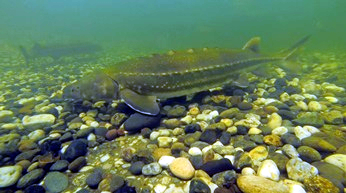Acipenser transmontanus
Distribution
 Adult White Sturgeon. CDFW photo by Mike Healey.
Adult White Sturgeon. CDFW photo by Mike Healey.
White Sturgeon are native to the West coast of North America, where they may be found in coastal waters from Ensenada, Mexico, to Alaska. Although occasionally found in the ocean, they primarily reside in large rivers and their associated estuaries, including the Sacramento-San Joaquin system in California, the Fraser River (British Columbia), and the Columbia River and its tributaries (Washington, Oregon, and Idaho). White Sturgeon in the Sacramento-San Joaquin system represent the southernmost spawning population of the species. Some spawning has recently been documented in the San Joaquin River, and may also occur in tributaries including the Feather, Yuba, and Bear rivers. Small runs may exist on the Russian, Klamath, Trinity, and Eel rivers, but it is not known if successful spawning occurs in those rivers.
Life History and Ecology
White Sturgeon are the largest fish that can be found in freshwater in North America. There are historical records of fish as large as 610 cm (20 ft), although it is now rare to encounter fish larger than 200 cm (6.5 ft) in Californian waters. The average White Sturgeon captured in the Delta in recent years is approximately 109 cm (3.6 ft). As with all Acipenserids, White Sturgeon are long-lived. The oldest fish on record was 103 years old at the time of capture, but most fish in the Delta are now believed to be less than 20 years old. Age at first reproduction is approximately 10-19 years old, with males maturing earlier and at a smaller size than females. Females produce an average of 5648 eggs per kilogram of body weight, and a 60 inch individual averages over 200,000 eggs. White Sturgeon in California spawn every 1-2 years for males and every 2-4 years for females. Adults migrate from the estuary into the river starting in December, spawn from February to June, and return to the Delta after spawning. The early life of White Sturgeon in the wild is still not well understood and in need of continued research. Current evidence indicates that dispersed, fertilized eggs settle to the bottom and stick hard surfaces. Eggs hatch into the larval stage after about 12 days. The newly hatched larvae swim actively for several days before settling to the bottom. Juveniles move rapidly down-river, taking up residence in the freshwater region of the estuary. As adults, White Sturgeon move throughout the San Francisco Bay Estuary, occasionally making forays into coastal waters.
Threats
The primary spawning habitat of Sacramento-San Joaquin White Sturgeon is a short reach of the middle Sacramento River, with some additional spawning occurring in the San Joaquin River, so the species is vulnerable to habitat loss and climate change that might degrade or destroy those areas. Other factors that threaten White Sturgeon include entrainment of early life stages into water diversions, contaminants from pollution and terrestrial runoff, and poaching and illegal fishing for meat and eggs. In 2022, a Harmful Algal Bloom was responsible for the deaths of over 850 sturgeon in San Francisco Bay.
Conservation and Management
A commercial fishery for White Sturgeon existed in the late 1800's but was shut down in 1901 by the state of California after numbers declined precipitously. Once the population recovered, a recreational harvest fishery for the species was permitted from 1954 through 2024. In July 2024, White Sturgeon became a candidate for listing as Threatened under the California Endangered Species Act. A Status Review is being conducted by CDFW and the species receives full protection during that period. The current status of the White Sturgeon population is monitored by CDFW using data from adult and juvenile surveys, and Sturgeon Fishing Report Cards.
In 2024, the California Department of Fish and Wildlife (CDFW) embarked on a new White Sturgeon population survey. The methods are based off white sturgeon surveys conducted in Oregon and Washington and modified for use in California. The study design has been peer-reviewed and is intended to be the most robust and comprehensive white sturgeon population monitoring survey ever conducted in California. Results from the first pilot year of the study, along with a technical report on the survey design, are available for download.
Species Status
On June 19, 2024, the California Fish and Game Commission voted to approve White Sturgeon as a candidate species for listing under the California Endangered Species Act (CESA). Final regulatory approval from the Office of Administrative Law came through on July 12, 2024. Candidate species for listing under CESA are granted full protections during the Status Review process.
Further details about the species can be found online in the CDFW White Sturgeon Enhanced Status Report. The American Fisheries Society considers the survival of sturgeon to be dependent on conservation measures taken to protect them.